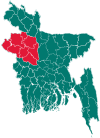Khetlal Upazila
Khetlal
ক্ষেতলাল | |
|---|---|
 Lake in Khetlal Upazila | |
 | |
| Coordinates: 25°1.5′N 89°8′E / 25.0250°N 89.133°E | |
| Country | |
| Division | Rajshahi |
| District | Joypurhat |
| Area | |
| • Total | 142.61 km2 (55.06 sq mi) |
| Population (2011) | |
| • Total | 108,326 |
| • Density | 760/km2 (2,000/sq mi) |
| Time zone | UTC+6 (BST) |
| Website | Official Map of Khetlal |
Khetlal (Bengali: ক্ষেতলাল) is an upazila of Joypurhat District in the Division of Rajshahi, Bangladesh.[1] Khetlal Thana was formed in 1847 and it was turned into an upazila on 3 July 1983. Khetlal Municipality was declared on 9 December 2010.
Geography[edit]
Khetlal Upazila, having an area of 142.61 km2, is located in between 24°56' and 25°08' north latitudes and in between 89°02' and 89°12' east longitudes. The upazila is bounded by Joypurhat Sadar Upazila on the north, Akkelpur and Dhupchanchia upazilas on the south, Kalai and Shibganj (Bogura) upazilas on the east, Joypurhat Sadar and Akkelpur upazilas on the west.[2]
Water bodies Main rivers: Tulsiganga, Harabati.
History[edit]
Khetlāl was listed in the Ain-i-Akbari (as "Khetnāl") as a mahal in sarkar Ghoraghat.[3]: 43 It was listed with an assessed revenue of 40,367 dams (this translation spells the name "Kaṇhṭál").[4]: 135
Demographics[edit]
According to the 2011 Bangladesh census, Khetlal Upazila had 29,805 households and a population of 108,326. 19,441 (17.95%) were under 10 years of age. Khetlal had a literacy rate (age 7 and over) of 53.47%, compared to the national average of 51.8%, and a sex ratio of 998 females per 1000 males. 11,711 (10.81%) lived in urban areas.[5][6]
Par the 2001 Bangladesh census, the upazila had a population of 115918 constituting 59274 males, 56644 females, 105728 Muslims, 9981 Hindus, 65 Buddhists, 18 Christians and 126 from other religions. Indigenous communities such as santal and oraon also belong to this upazila.[1][7]
Administration[edit]
Khetlal Upazila is divided into Khetlal Municipality and five union parishads:Alampur, Barail, Baratara, Khetlal, and Mamudpur. The union parishads are subdivided into 88 mauzas and 155 villages.[5]
Khetlal Municipality is subdivided into 9 wards and 9 mahallas.[5]
See also[edit]
References[edit]
- ^ a b Shahnaz Parveen (2012), "Khetlal Upazila", in Sirajul Islam and Ahmed A. Jamal (ed.), Banglapedia: National Encyclopedia of Bangladesh (Second ed.), Asiatic Society of Bangladesh
- ^ "Khetlal Upazila - Banglapedia". en.banglapedia.org. Retrieved 2023-02-22.
- ^ Habib, Irfan (1982). An Atlas of the Mughal Empire. Oxford University Press. ISBN 0195603796. Retrieved 26 March 2023.
- ^ Abu'l-Fazl ibn Mubarak (1891). The Ain-i-Akbari. Translated by Jarrett, Henry Sullivan. Calcutta: Asiatic Society of Bengal. Retrieved 21 January 2021.
- ^ a b c d "Bangladesh Population and Housing Census 2011 Zila Report – Joypurhat" (PDF). bbs.gov.bd. Bangladesh Bureau of Statistics.
- ^ "Community Tables: Joypurhat district" (PDF). bbs.gov.bd. Bangladesh Bureau of Statistics. 2011.
- ^ "Population Census Wing, BBS". Archived from the original on 2005-03-27. Retrieved November 10, 2006.

